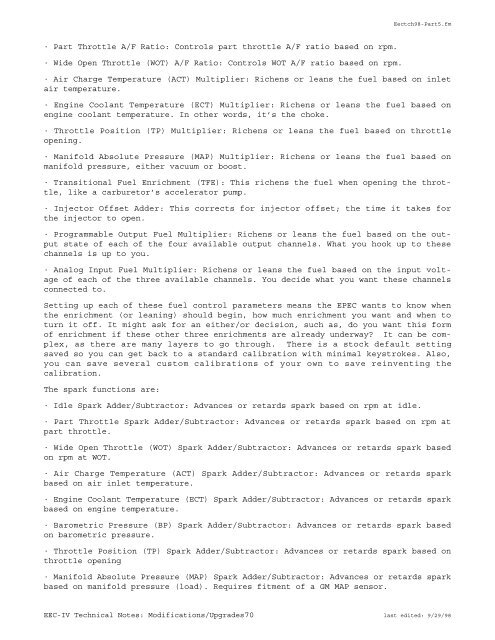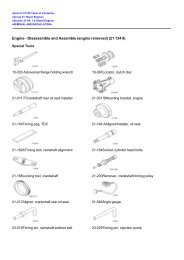TECHNICAL NOTES ON THE EEC-IV MCU - Auto diagnostics
TECHNICAL NOTES ON THE EEC-IV MCU - Auto diagnostics
TECHNICAL NOTES ON THE EEC-IV MCU - Auto diagnostics
Create successful ePaper yourself
Turn your PDF publications into a flip-book with our unique Google optimized e-Paper software.
· Part Throttle A/F Ratio: Controls part throttle A/F ratio based on rpm.<br />
· Wide Open Throttle (WOT) A/F Ratio: Controls WOT A/F ratio based on rpm.<br />
Eectch98-Part5.fm<br />
· Air Charge Temperature (ACT) Multiplier: Richens or leans the fuel based on inlet<br />
air temperature.<br />
· Engine Coolant Temperature (ECT) Multiplier: Richens or leans the fuel based on<br />
engine coolant temperature. In other words, it’s the choke.<br />
· Throttle Position (TP) Multiplier: Richens or leans the fuel based on throttle<br />
opening.<br />
· Manifold Absolute Pressure (MAP) Multiplier: Richens or leans the fuel based on<br />
manifold pressure, either vacuum or boost.<br />
· Transitional Fuel Enrichment (TFE): This richens the fuel when opening the throttle,<br />
like a carburetor’s accelerator pump.<br />
· Injector Offset Adder: This corrects for injector offset; the time it takes for<br />
the injector to open.<br />
· Programmable Output Fuel Multiplier: Richens or leans the fuel based on the output<br />
state of each of the four available output channels. What you hook up to these<br />
channels is up to you.<br />
· Analog Input Fuel Multiplier: Richens or leans the fuel based on the input voltage<br />
of each of the three available channels. You decide what you want these channels<br />
connected to.<br />
Setting up each of these fuel control parameters means the EPEC wants to know when<br />
the enrichment (or leaning) should begin, how much enrichment you want and when to<br />
turn it off. It might ask for an either/or decision, such as, do you want this form<br />
of enrichment if these other three enrichments are already underway? It can be complex,<br />
as there are many layers to go through. There is a stock default setting<br />
saved so you can get back to a standard calibration with minimal keystrokes. Also,<br />
you can save several custom calibrations of your own to save reinventing the<br />
calibration.<br />
The spark functions are:<br />
· Idle Spark Adder/Subtractor: Advances or retards spark based on rpm at idle.<br />
· Part Throttle Spark Adder/Subtractor: Advances or retards spark based on rpm at<br />
part throttle.<br />
· Wide Open Throttle (WOT) Spark Adder/Subtractor: Advances or retards spark based<br />
on rpm at WOT.<br />
· Air Charge Temperature (ACT) Spark Adder/Subtractor: Advances or retards spark<br />
based on air inlet temperature.<br />
· Engine Coolant Temperature (ECT) Spark Adder/Subtractor: Advances or retards spark<br />
based on engine temperature.<br />
· Barometric Pressure (BP) Spark Adder/Subtractor: Advances or retards spark based<br />
on barometric pressure.<br />
· Throttle Position (TP) Spark Adder/Subtractor: Advances or retards spark based on<br />
throttle opening<br />
· Manifold Absolute Pressure (MAP) Spark Adder/Subtractor: Advances or retards spark<br />
based on manifold pressure (load). Requires fitment of a GM MAP sensor.<br />
<strong>EEC</strong>-<strong>IV</strong> Technical Notes: Modifications/Upgrades70 last edited: 9/29/98




